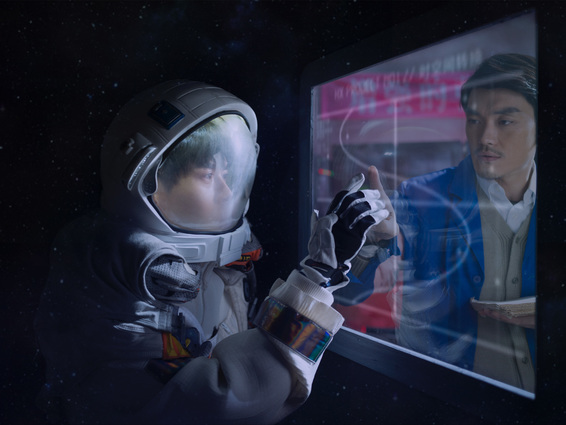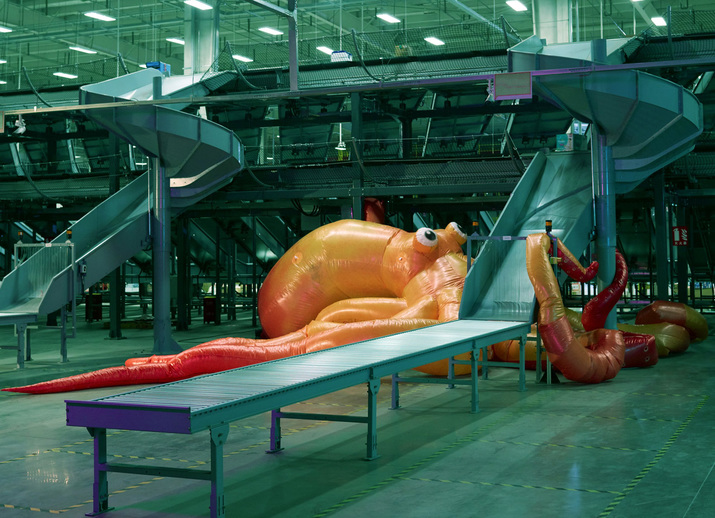-
From Current Issue
-
- Editor’s Letter Fire in the Heart
- Reviews I Gusti Ayu Kadek Murniasih
- Reviews 11th Seoul Mediacity Biennale: “One Escape at a Time”
- Dispatch Networked China
- One on One Monira Al Qadiri on Yukio Mishima
- Essays The rise of independent art spaces in pandemic-era Shanghai
- Features Tuan Andrew Nguyen
- Table of Contents
- Web Exclusives
- Archive
- Subscribe

R
E
V N
E
X
T
Installation view of CAO FEI’s “Blueprints,” at Serpentine Gallery, London, 2020. Photo by Gautier Deblonde. Courtesy Serpentine Gallery.
“Blueprints,” Cao Fei’s exhibition at the Serpentine Gallery is a grimly earnest speculation about human nature’s shifting responses to technological progress. Expressed in over three-and-a-half hours of film, a virtual reality (VR) installation, and collected ephemera, the artist’s perseverance in engaging viewers with her concerns is laudable. Yet, this multi-dimensional experience tends to belabor its points, while the lengthy works could be too slow for some.
A replica of the entrance lobby of Beijing’s Hongxia Theatre—a place of pastel green walls, polished floor tiles, and a reception desk dressed with generic flowers—begins the journey. Formerly a cinema and meeting place for electronic factory workers modeled after Soviet examples, and currently Cao’s studio, this space tells a story of Sino-Soviet relations. Cao’s archive of the neighborhood and its memories, displayed in vitrines and recollected in the film Hongxia (2019)—screened through the face of an ATM machine—recall the industrial implications of Communist consanguinity, as the location also produced parts for China’s first computer.
The factory workers are brought back to life by gallery attendants who, dressed in blue boiler suits with pink arm bands, acted as ushers for Nova (2019)—Cao’s first feature-length film—and The Eternal Wave (2020), a VR experience featuring the old Hongxia Theatre. The film, which follows a scientist’s attempts at turning his son into a digital being, is stunning: wide-angle views of brutalist buildings make way for chilling scenes set in a void. A dystopian dance sequence amid the burnt-out shell of a factory segues into a bright tropical beach. The gripping visuals, however, appear disjointed, at times overwhelming the narrative. Furthermore, for a show premised on the rise of virtual worlds, the closure of The Eternal Wave when I visited was subversive. Or, did this augment Cao’s position, making the case for human IRL interaction?
Sacrifices made at the altar of technological advance dominated the exhibition. Two films hung in dialogue; Asia One (2018) and Whose Utopia (2006) both foreground humans in capitalist models of labor and production. Asia One is a morose overview of an automated warehouse, where boxes seamlessly glide across a conveyor belt as a monitoring robot increasingly aggravates the only two human workers. A shared loathing for their sanctimoniously efficient workplace spawns a relationship between the duo, but this is not explored further. Whose Utopia, set in a lighting factory, disrupts the mechanical choreography of the place to show liberated workers indulging in songs, dancing, and tai chi. The moments of rapturous reprieve in both films cleverly illustrate the human cost of economies anchored in consumption.
While Cao’s meditations on factory culture may seem interminably meandering to some, her aesthetics are invested with the power to hold attention. At its most succinct, the show is rich, and intelligently builds on extensive research combining references to China’s historic sci-fi industry with contemporary fieldwork, giving an unnerving premonition of the future.
Cao Fei’s “Blueprints” was scheduled to be on view at Serpentine Gallery, London, until May 17, 2020. Please check the exhibition web page for up-to-date information in light of Covid-19.
To read more of ArtAsiaPacific’s articles, visit our Digital Library.


















